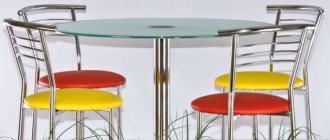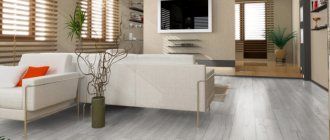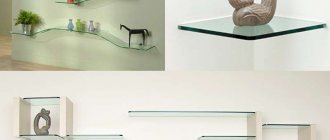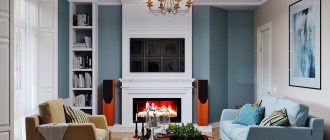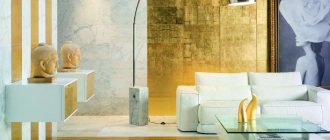Different chairs in the dining area are no longer new. At one time, this technique could be appreciated by viewers of the series “Friends” - mismatched chairs surrounded the dining table in Monica’s apartment. But even now this decision is relevant, interesting and quite bold. It is necessary to show artistic taste and a sense of proportion in order to obtain as a result not a chaotic jumble, but a beautiful medley. If you're attracted to this idea but are worried about making a mistake with the layout, try one of the common designs below.
Interior from the series "Friends"
Chair in the interior: characteristics and design features
The existing variety of types and shapes of chairs can be divided into three main groups:
- ordinary,
- bar,
- semi-chair (chair-chair).
Each chair has legs connected to the seat in one way or another, and a backrest - this is its main difference from stools. The bar is taller, and the half-chair has armrests. An armchair chair in an interior is usually used as a single item, replacing a full-size chair, especially in small rooms.
In order to correctly determine the appropriate size, it is best to sit directly on the selected product, but there are also general selection patterns that you can focus on. What should you pay attention to before making a purchase?
Seat
- Height. A sitting person should have their feet on the floor and their knees bent at right angles. Tall and very short people need chairs of different heights. In large families, it is convenient to use adjustable seat heights, for example, using a gas lift mechanism.
- Depth. The length of the legs is also different for everyone. It is bad if the edge of the seat rests on the popliteal fossa. As a rule, the depth should be at least 45 cm.
- Width. For a fat person, chairs that are too narrow are uncomfortable, so the optimal seat width is at least 40 cm. If you are purchasing an armchair for the interior of your apartment, keep in mind that the width between the armrests is limiting; if it is insufficient, comfort will suffer.
- Rigidity. The seat can be hard, semi-soft or soft. The seat of a semi-soft chair has a built-in “cushion” about 4 cm thick, covered with fabric or leather, a soft one has a cushion more than 4 cm thick with or without a spring block, a hard one does not have a softening pillow at all.
Weight
Very lightweight chairs are easy to move, slide under and out of tables, and this is definitely a useful feature. However, heavy options look much more solid and add weight to the interior, both literally and figuratively. In addition, they are safer - it is almost impossible to fall from them, you cannot swing on them, which is especially important for families with children.
Tip: The back of the chair can be of any height, but it must be comfortable and fulfill its main purpose - to support your back.
Design
Design features allow us to divide all produced models into two main types:
- solid,
- collapsible.
In addition, they differ in storage capabilities:
- stackable,
- folding.
Solid chairs are the most common option; they are convenient in fairly spacious apartments. Small apartments where you have to save space are best equipped with collapsible chairs, which can either be folded or stacked and put away in a closet or on the balcony.
Two main chairs at the edges of the table
A universal method that creates the necessary symmetry. The two chairs at the head of the table must certainly be more interesting than those standing along. Choose chairs that are different in color, upholstery and even height.
Types of materials for chairs
The material used to create the chair determines its strength, reliability and how it will look. But we choose this piece of furniture primarily based on how it looks in the interior of the apartment.
Wooden chairs
Wooden chairs in the interior of any home will give it solidity and solidity. The color and texture of natural wood will suit almost any style and create an atmosphere of special warmth and comfort. There are three types:
- carpentry (made from straight pieces of wood);
- bent (from wood processed in a special way, which is given smooth shapes, for example, Viennese);
- glued (from valuable wood veneer).
The price of the product depends on the type of wood and manufacturing method. All possible types of chairs are made from wood.
Metal chairs
This is a very resistant and durable material; it is usually used in combination with wood or plastic, making seats from them, or providing an all-metal product with a cushion. Metal corners, tubes, profile or forged elements can be used as a base. Forged metal chairs in a Provence style interior emphasize its simplicity and at the same time sophistication. Chairs made of chrome-plated metal parts are suitable for minimalism and hi-tech styles.
Plastic chairs
Since the early sixties, this material has been gradually gaining popularity, and with the invention of more and more new types of it, this popularity is only growing. Strong, durable, non-fading, painted in any color, plastic chairs “began” as equipment for cafes and hotels, and now they have conquered apartments.
Another advantage of plastic is that it can imitate glass. Transparent chairs in the interior are used in cases where you don’t want to clutter up the volume of the room - they are almost invisible, and at the same time comfortable. With their help you can achieve interesting decorative effects.
Wicker chairs
Wicker chairs have a number of features. They are very light, their seats are softly springy, providing a comfortable fit. In Russia, such chairs were woven from willow, they were inexpensive and available to everyone. If necessary, a chair or even an armchair could be woven yourself.
Nowadays, wicker chairs have become one of the almost obligatory elements of “rustic” interior styles and have gained great popularity - in the “concrete jungle” of big cities they provide an opportunity to remember nature. Chairs made of synthetic materials are also gaining popularity - sitting in them is comfortable and pleasant, and they do not cling to clothes, unlike willow and rattan rods.
Combined chairs
In many models you can find a combination of different materials, for example, the base and legs can be made of metal, and the seat can be made of plastic or wood.
No rules!
For those who are not afraid of aesthetic experiments and trust their intuition: mix whatever you want! Sometimes, thanks to expression and rejection of rules, the most interesting design spaces are born. Don’t be afraid to make your home different from others, the main thing is that you like it.
Photos: zillow.com
Add to favorites6
- Tags
- useful tips
useful tips
Placement of chairs in the interior
The appearance of the chair is determined by where you are going to place it. Dining room, kitchen, balcony, bedroom, nursery - everywhere there is a place for this familiar piece of furniture, and everywhere it will be different. Chairs in the kitchen interior must withstand high temperatures and humidity, be easy to clean and durable. Hard seats are appropriate here, since the upholstery on semi-soft and soft ones can easily become dirty. For the living room, the main criterion is compliance with the design, for the children’s room – safety.
Chairs in the kitchen interior
If the kitchen has a dining area, you need to be especially careful when choosing chairs.
- Chairs should be easy to clean, they do not need semi-upholstered or soft seats with fabric upholstery, if hard is not for you, choose upholstery made of leather or washable fabric, which is easy to care for.
- The back should not be too high so as not to cause inconvenience.
- Too elaborate and complex shapes are undesirable - they can interfere with movement during cooking and are more difficult to care for.
A very interesting option, especially for small kitchens, are chairs made of transparent plastic. They do not visually clutter the room, and look very interesting, adding a play of light reflections from the smooth surface to the interior. As a rule, plastic chairs can be stacked, which is convenient if you need to free up more space or do cleaning.
Kitchen chairs in the interior should, first of all, be comfortable and not distract from eating. However, this doesn't mean they have to be boring. Chairs designed by famous designers and mass-produced can fully satisfy all requirements, add uniqueness and charm to the room and will look great in the kitchen, living room, and studio space.
Unusual and exclusive designer chairs in the kitchen interior can be very beautiful in themselves, but they will interfere rather than facilitate the processes in the kitchen, and besides, due to the saturation of furniture, they are unlikely to be clearly visible.
Chairs in the living room interior
It is not always possible to get by in a reception room with a classic sofa and a couple of armchairs. This is not convenient for everyone and not in all cases; for older people, for example, it is quite difficult to sit down on a low sofa and then get up from it. The main requirement for all items in the living room, which is essentially the face of the house, is compliance with the chosen style.
Chairs are no exception. The material from which they are made may coincide with the material of the rest of the furniture, or may contrast - but this contrast must be justified and aesthetically pleasing.
As a rule, the backs of chairs intended for the living room are 10-20 cm higher than those of other types. High dining chairs in the living room interior look elegant and expensive. If in the kitchen chairs have a mainly utilitarian purpose, then in the living room you can safely experiment. This is more of a decorative element; with their help you can place the necessary accents.
Designer masterpieces can become the main art objects in the living room and fulfill the same role that paintings by famous artists play in interiors - attract attention, provide a topic for conversation, and introduce an element of exclusivity.
Choosing the right pink color
Quite often, when hearing the word pink, many people have not very pleasant associations, since this shade is considered to be girly and overly childish.
But, as a rule, this is associated with bright pink, doll-like tones, although in fact the range of colors here can be represented by the most incredible shades that can be used even in a man’s bedroom.
Therefore, before you design your bedroom in pink tones, you should pay attention to the following basic shades and their characteristics:
- Light cool shades include creamy pink, white-lilac, pearl, pale dogwood, creole, peach blush.
- To light warm ones - apricot blush, flowering shade, peach cream, coral cloud, shell color.
- Bright classic ones include pink geranium, begonia, aurora, lilac chiffon, almond, coral.
- To muted, but quite rich - ice strawberry, wild orchid, pink lemonade, azalea, cashmere rose.
In the case when choosing a color for a bedroom, which is maintained in modern styles, such as hi-tech, loft, industrial - you can use the following shades of pink - Malagana, ash rose, jelly, rose wine, twilight orchid, lilac-wood, heather, ash rose, raspberry radiance, cactus flower, berry.
Such fairly thick, rich colors are also ideal when the bedroom is decorated for a married couple, but the man is categorically against exclusively feminine colors.
As you can see, the diverse spectrum allows you to choose the shade of pink for each occasion individually, which allows you to create a wide variety of interiors.
Chair design in a modern interior
Style decision
There are an endless variety of styles in which chairs can be made. They almost always have something in common with the design styles themselves, but they can all be divided into several groups:
- classic;
- modern;
- vintage styles.
Among modern styles, minimalism and hi-tech are the most popular; non-standard forms and the latest technological solutions satisfy the tastes of most users.
Color solution
It all depends on whether you want to “hide” your chairs, leaving them with a purely utilitarian function, or whether you want to draw attention to them, turning them into an interior accent. In the first case, you should choose colors that are close to the background color - the walls or the rest of the furniture. In the second, on the contrary, the color can be contrasting and even very bright.
It is absolutely not necessary to make all the upholstery of the chairs the same color; it is enough to highlight only one as an accent tone, leaving the rest in the background. The laws of the influence of color on the psyche also work for kitchen furniture: delicate pastel colors soothe, the red part of the visible spectrum stimulates the appetite, and the blue mutes it.
Orange apron in the kitchen
An excellent option to dilute a classic kitchen with bright shades is to design an apron in orange. This method, of course, is suitable for sets whose facade color is combined with shades of orange.
The apron can be either plain or with a pattern. This will depend on the design of the facades of the set - for a multi-colored kitchen or kitchens with patterns, the most successful option would be a plain apron. The material for it can be different: glass, ceramic tiles, chipboard and even brickwork.
For example, for a kitchen area in a brutal loft style, a dark, monochromatic kitchen set will be perfect, complemented by bright orange brickwork. This design must be decorated with warm lighting; the kitchen will be stylish and very cozy.
A plain bright orange apron can also be used in a minimalist style, combining it with light glossy kitchen facades.
A popular backsplash option for more conservative styles is mosaic tiles in orange shades. At the same time, kitchen facades made of dark wood look most advantageous.
Are the chairs the same or different in the interior?
The usual option is a dining group that allows you to seat your family. These are four or six chairs, usually exactly the same. The option is a win-win, but quite typical. Try to abandon the standard scheme and combine different chairs in the interior of one room. The result can be great.
Quite often, a family has one or two chairs with history that are a pity to throw away. For example, they are made of real wood and are at the peak of fashion today, but it is impossible to combine them with other furnishings. To “fit” an exclusive item into the overall context of the interior, try to follow the advice of designers.
- To highlight one chair in the interior, paint it in an accent color. For example, wooden chairs are usually not painted, leaving the wood texture on display as an addition to the interior. A painted wooden chair in any style interior immediately attracts attention, especially if the color is bright.
- Do you want to fit an unusual chair into your existing dining room? Change the upholstery to match and a different shaped chair will look great in a group. You can also combine an exclusive item with a group using color or a homogeneous material.
- Place chairs of different shapes next to each other, painted in the same color. The resulting group will add originality and good mood to the interior.
- Using different shades of the same color can also serve as a unifying tool.
- A boring dining set can be radically transformed by choosing its own upholstery for each chair, or by painting the same items in different colors.
- Assemble chairs of different shapes, paint them the same color and cover the seats with the same material.
Variety of shades
If orange for you is exclusively the color of a ripe orange fruit, then get ready to break the pattern: there are more than a hundred (!) of its shades. They differ not only in color temperature, but also in their influence on the mood in the interior:
- apricot - bias towards pale yellow, zones the space well;
- aurora - lightened orange-pink;
- vermilion - bright scarlet with an orange tint;
- chestnut - reddish-brown;
- coral - pink-orange color, gentle and delicate, universal;
- tangerine - named after the fruit, creates an active, cheerful background;
- honey - between orange and brown, creates a peaceful atmosphere;
- carrot - a bright and joyful shade;
- peach - reddish light orange, better suited for wall decoration;
- orange - a burning and dynamic orange-red, for spacious rooms;
- rusty - dark, red-brown;
- tango - orange with a brown tint, optimal for ethnic interiors;
- amber is a mixture of orange and yellow, very rich and dark.


